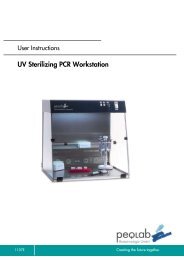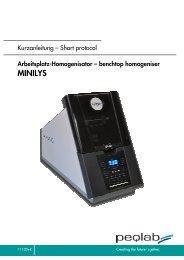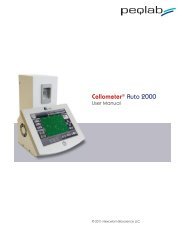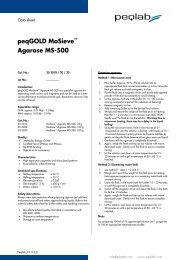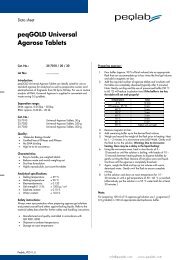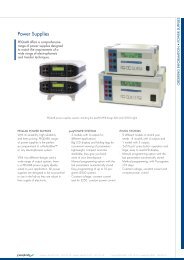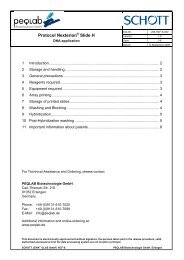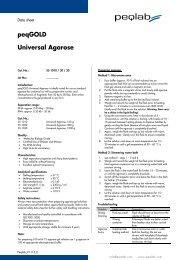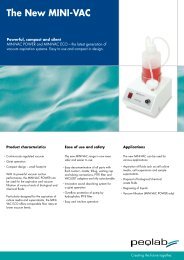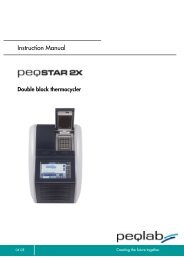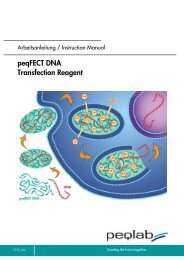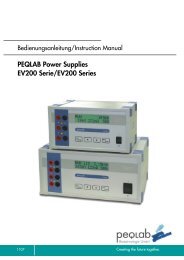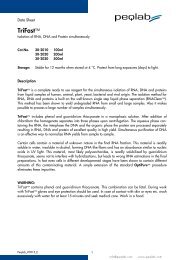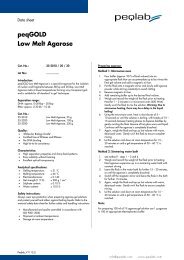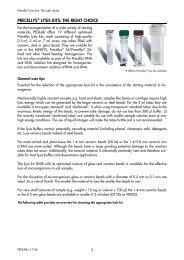peqGOLD 50 bp DNA-Ladder Orange G - Peqlab
peqGOLD 50 bp DNA-Ladder Orange G - Peqlab
peqGOLD 50 bp DNA-Ladder Orange G - Peqlab
Create successful ePaper yourself
Turn your PDF publications into a flip-book with our unique Google optimized e-Paper software.
Data Sheet<br />
<strong>peqGOLD</strong> <strong>50</strong> <strong>bp</strong> <strong>DNA</strong>-<strong>Ladder</strong> <strong>Orange</strong> G<br />
'improved version'<br />
Lot-No. ........<br />
Concentration<br />
Usage<br />
0.1 mg <strong>DNA</strong>/ml<br />
1 µl (0.1 µg)/mm Lane<br />
Order-No. 25-23<strong>50</strong> 1 x <strong>50</strong> µg 1 x 1 ml <strong>Orange</strong> G Loading buffer for samples (6x)<br />
25-2351 5 x <strong>50</strong> µg 2 x 1 ml <strong>Orange</strong> G Loading buffer for samples (6x)<br />
Description<br />
<strong>peqGOLD</strong> <strong>50</strong> <strong>bp</strong> <strong>DNA</strong>-<strong>Ladder</strong> <strong>Orange</strong> G consists of fragments derived from specially digested <strong>DNA</strong><br />
of plasmid pEJ3, which contains pUC, λ phage and Yeast sequences. The marker is shipped 'ready-<br />
to-use'<br />
in Loading buffer (10 mM Tris-HCl (pH 7.6), 10 mM EDTA, 0.025 % <strong>Orange</strong> G, 0.005 %<br />
xylene cyanol and 10 % glycerol)<br />
13 Fragments 1000, 900, 800, 700, 600, <strong>50</strong>0, 400, 300, 2<strong>50</strong>, 200, 1<strong>50</strong>, 100 and <strong>50</strong> base pairs<br />
6x <strong>Orange</strong> G<br />
Loading buffer<br />
Note<br />
10 mM Tris-HCL (pH 7.6), 0.15 % <strong>Orange</strong> G, 0.03 % xylene cyanol, 60 % glycerol and 60 mM EDTA<br />
<strong>peqGOLD</strong> <strong>50</strong> <strong>bp</strong> <strong>DNA</strong>-<strong>Ladder</strong> <strong>Orange</strong> G is ideal for sizing of unknown <strong>DNA</strong> fragments in the range<br />
of <strong>50</strong> to 1031 base pairs. Additional weak bands might occur in agarose gels which result from<br />
circular forms of <strong>DNA</strong> ligation products.<br />
The 'improved version' is characterized by equalized amounts of <strong>DNA</strong> per band for easier<br />
quantification. The 1031 <strong>bp</strong> fragment was replaced by a 1000 <strong>bp</strong> fragment. The <strong>50</strong>0 <strong>bp</strong> and the 2<strong>50</strong><br />
<strong>bp</strong> fragments were introduced as new reference bands.<br />
Loading<br />
Agarose and non-denaturing Polyacrylamide gels:<br />
<strong>peqGOLD</strong> <strong>50</strong> <strong>bp</strong> <strong>DNA</strong>-<strong>Ladder</strong> <strong>Orange</strong> G is ready-to-use and can be applied directly to the gel:<br />
Vortex marker briefly.<br />
Load 1 µl (0.1 µg) <strong>DNA</strong>-<strong>Ladder</strong> per 1 mm lane width<br />
Visualize fragments after electrophoretic separation by ethidium bromide-staining. Do not heat before<br />
loading. <strong>50</strong> µg marker are sufficient for approx. 100 lanes (5 mm Lane width).<br />
<strong>Peqlab</strong>_V0911_E<br />
info@peqlab.com · www.peqlab.com
<strong>peqGOLD</strong> <strong>50</strong> <strong>bp</strong> <strong>DNA</strong>-<strong>Ladder</strong> <strong>Orange</strong> G<br />
Quantification<br />
See the graph for the percentage of the bands and the<br />
amount of <strong>DNA</strong> per band in ng, relating to 0.5 µg loaded<br />
marker. Use the same volume of <strong>DNA</strong> and marker.<br />
Additionally the concentration of loading buffer in samples<br />
and marker should be equal.<br />
Note<br />
Ethidium bromide migrates contrarily to the <strong>DNA</strong> during<br />
electrophoresis. Therefore the distribution of ethidium<br />
bromide in the gel is not constant. To ensure equal<br />
distribution of ethidium bromide in the gel add 0.5 mg/l<br />
ethidium bromide to electrophoresis buffer or dye the gel after<br />
the run.<br />
Shipment: blue ice<br />
Storage: + 4 °C/– 20 °C<br />
Stability: up to 6 months at + 4 °C<br />
minimum 18 months at – 20 °C<br />
<strong>Peqlab</strong>_V0911_E<br />
info@peqlab.com · www.peqlab.com



